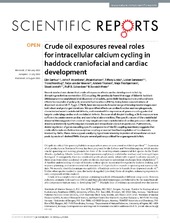| dc.contributor.author | Sørhus, Elin | |
| dc.contributor.author | Incardona, John P. | |
| dc.contributor.author | Karlsen, Ørjan | |
| dc.contributor.author | Linbo, Tiffany | |
| dc.contributor.author | Sørensen, Lisbet | |
| dc.contributor.author | Nordtug, Trond | |
| dc.contributor.author | van der Meeren, Terje | |
| dc.contributor.author | Thorsen, Anders | |
| dc.contributor.author | Thorbjørnsen, Maja | |
| dc.contributor.author | Jentoft, Sissel | |
| dc.contributor.author | Edvardsen, Rolf | |
| dc.contributor.author | Meier, Sonnich | |
| dc.date.accessioned | 2016-09-14T13:27:13Z | |
| dc.date.available | 2016-09-14T13:27:13Z | |
| dc.date.issued | 2016-08-10 | |
| dc.Published | Scientific Reports 2016, 6:31058 | eng |
| dc.identifier.issn | 2045-2322 | en_US |
| dc.identifier.uri | https://hdl.handle.net/1956/12802 | |
| dc.description.abstract | Recent studies have shown that crude oil exposure affects cardiac development in fish by disrupting excitation-contraction (EC) coupling. We previously found that eggs of Atlantic haddock (Melanogrammus aeglefinus) bind dispersed oil droplets, potentially leading to more profound toxic effects from uptake of polycyclic aromatic hydrocarbons (PAHs). Using lower concentrations of dispersed crude oil (0.7–7 μg/L ∑PAH), here we exposed a broader range of developmental stages over both short and prolonged durations. We quantified effects on cardiac function and morphogenesis, characterized novel craniofacial defects, and examined the expression of genes encoding potential targets underlying cardiac and craniofacial defects. Because of oil droplet binding, a 24-hr exposure was sufficient to create severe cardiac and craniofacial abnormalities. The specific nature of the craniofacial abnormalities suggests that crude oil may target common craniofacial and cardiac precursor cells either directly or indirectly by affecting ion channels and intracellular calcium in particular. Furthermore, down-regulation of genes encoding specific components of the EC coupling machinery suggests that crude oil disrupts excitation-transcription coupling or normal feedback regulation of ion channels blocked by PAHs. These data support a unifying hypothesis whereby depletion of intracellular calcium pools by crude oil-derived PAHs disrupts several pathways critical for organogenesis in fish. | en_US |
| dc.language.iso | eng | eng |
| dc.publisher | Nature Publishing Group | en_US |
| dc.rights | Attribution CC BY | eng |
| dc.rights.uri | http://creativecommons.org/licenses/by/4.0/ | eng |
| dc.title | Crude oil exposures reveal roles for intracellular calcium cycling in haddock craniofacial and cardiac development | en_US |
| dc.type | Peer reviewed | |
| dc.type | Journal article | |
| dc.date.updated | 2016-08-24T12:10:10Z | |
| dc.description.version | publishedVersion | en_US |
| dc.rights.holder | Copyright The Author(s) 2016 | en_US |
| dc.identifier.doi | https://doi.org/10.1038/srep31058 | |
| dc.identifier.cristin | 1371929 | |
| dc.relation.project | Norges forskningsråd: 234367 | |
| dc.subject.nsi | VDP::Matematikk og naturvitenskap: 400::Zoologiske og botaniske fag: 480::Marinbiologi: 497 | |
| dc.subject.nsi | VDP::Mathematics and natural scienses: 400::Zoology and botany: 480::Marine biology: 497 | |
| dc.subject.nsi | VDP::Matematikk og naturvitenskap: 400::Kjemi: 440::Miljøkjemi, naturmiljøkjemi: 446 | |
| dc.subject.nsi | VDP::Mathematics and natural scienses: 400::Chemistry: 440::Environmental chemistry, natural environmental chemistry: 446 | |

